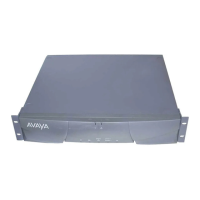Maintenance Commands
555-233-143
7-258 Issue 1 May 2002
Both demand and spontaneous PNC interchanges are prevented by the following
conditions:
■ The standby PNC is busied out.
■ The PNCs are locked by means of the set pnc lock or reset PNC
override-and-lock
commands.
■ For five minutes after a spontaneous PNC interchange, or for 30 seconds
after a demand interchange, an anti-thrashing mechanism prevents
subsequent interchanges unless the override-and-lock option is used.
■ If the standby PNC’s state of health is lower than the active PNC’s, the
command will abort unless the override-and-lock option is used.
■ If the standby PNC has not completed a global refresh since it was last
initialized or released, the reset will abort unless the override-and -lock
option is used.
Note the following caution regarding the use of the override-and-lock option.
See
status pnc for details of how to obtain and interpret the states of health and
other current information about the PNCs. For a more complete explanation of
PNC duplication and interchanges, see PNC-DUP in Chapter 8.
Parameters
interchange ”interchange” (without a preceding hyphen) must be specified on the
command line.
override-and-lock This option is also used to override the anti-thrashing mechanism.
Subsequent PNC interchanges are prevented, regardless of changes in the
states health of the PNCs. Double call setup still takes place; each call is set
up on both PNCs. To unlock the PNCs, use set pnc unlock.
!
CAUTION:
This option forces execution of the interchange regardless of the
standby’s state of health, possibly disrupting service.

